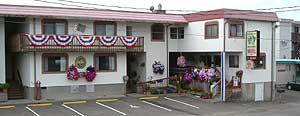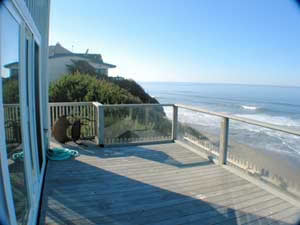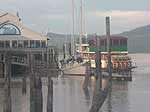 |
Oregon Coast Sand Uncovers Ancient Artifacts, Forest and Formations |
|---|
Covering 180 miles of Oregon coast travel: Astoria, Seaside, Cannon Beach, Manzanita, Nehalem, Wheeler, Rockaway, Garibaldi, Tillamook, Oceanside, Pacific City, Lincoln City, Depoe Bay, Newport, Waldport, Yachats & Florence.
02/19/08
Secrets of the Season |
Oregon Coast Sand Uncovers Ancient Artifacts, Forest and Formations
 |
| Cannon found in Arch Cape (photo Tiffany Boothe, Seaside Aquarium) |
(Arch Cape, Oregon) - The big buzz on Oregon's coast has been the archaeological find of two cannons that may be 162 years old, but there’s more that’s been uncovered by low sand levels: strange formations that look like something out of Dr. Suess and forest stumps at least 4,000 years old.
It all began this weekend as a family vacationing in Arch Cape – just south of Cannon Beach - discovered a cannon sticking out of the sand. At first, no one believed the teenager and her family, but eventually officials came around and acknowledged the find.
Immediately, locals realized these could be missing cannons from the USS Shark, which crashed on the Columbia River Bar, some 20 miles north of here, in 1846. It was on this beach that a cannon was found years later, getting Cannon Beach its name (after the village of Arch Cape had the name for a while).
Now, the nation, and especially Oregon media, is buzzing about the historical find, with the answer to a puzzle more than 150 years old possibly at hand.
 Tiffany
Boothe of the Seaside Aquarium went down to the scene to photograph it
and watch the media frenzy. She said the family was looking at stumps
from an ancient forest floor when they found what looked like just another
stump, except that this stump had rust on it.
Tiffany
Boothe of the Seaside Aquarium went down to the scene to photograph it
and watch the media frenzy. She said the family was looking at stumps
from an ancient forest floor when they found what looked like just another
stump, except that this stump had rust on it.
“Soon they had nearly dugout the entire cannon,” Boothe said. “While media crews and government officials flocked to check out the cannon, they found another amazing discovery: the other cannon.”
The cannons have been taken out of the sand by Oregon State Parks officials, loaded onto a pickup truck and will be taken to a state parks facility nearby. State Parks information officer Chris Havel said they will be placed in a similar environment of salt water tanks to keep them preserved.
Havel said State Parks archaeologist Dennis Griffin is currently onsite, helping park rangers decide when and if the objects will be moved. Also on site are historians from the Columbia River Maritime Museum.
Who will determine the cannons’ origin is still unknown. “They’ll probably put together a team of historians,” Havel said. “We don’t know if that will include people from outside the state or what.”
 |
| Arch Cape |
That determination may take two years, as researchers will have to look at many things, including comparing the wood on the cannon to the wood of the USS Shark.
Exactly what happens with these objects down the line is unknown as well. It depends on who actually owns the land the cannons were found on. Although the state of Oregon technically owns most of the beaches in the state, there are other factors that may mean a private entity owns the land.
|
Arch
Cape Property Services.
Dozens of homes in that dreamy,
rugged stretch between Cannon Beach and Manzanita known as Arch
Cape. Oceanfront and ocean view , or just a short walk from the
sea. |
“That will most likely determine who owns the land,” Havel said. “It could be the Division of State Lands, or it could be State Parks, or someone else, depending on exactly where they are and how close to the tide line.”
In the meantime, crowds have gathered to watch the spectacle. State Parks officials were encouraging people to come and take a look, but urging them not to touch or take pieces of them.
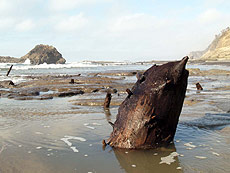 |
| Stumps in Arch Cape this year (photo Boothe) |
“Out hope is that they will be preserved,” Havel said of their final destination.
As Boothe and aquarium manager Keith Chandler were documenting the historic finds, they discovered something even stranger and older right beneath the feet of media and onlookers.
Stumps from a forest probably around 4,000 years old have popped up in Arch Cape, as well as some unusual formations called red towers. Geologists will be having a field day with these in the coming weeks, as the stumps at Arch Cape rarely show up, and one theory has them as old as 80,000 years old. The red towers are also quite a sight, looking a bit like something out of a Dr. Suess book or Yes album cover.
“We noticed not only stumps that had been uncovered but the forest floor as well,” Boothe said. “As you know Arch Cape is a steep beach with many rocks that lead down to flat sand. These photographs show where the sand has been swept away by the heavy winter surf and exposed this extremely fragile floor. When walking on the floor it resembles clay or mud.”
 |
| Arch Cape ghost forest (photo Boothe) |
|
The Ocean Lodge. There will not be another property built like this in Cannon Beach in our lifetimes. Rare, premiere ocean front location; handsome, dramatic architecture and tasteful, fun (nostalgic) beach interiors. Overlooks Haystack Rock. 100 percent smoke free. Imaginative special occasion packages. Massive wood burning lobby fireplace. Library w/ fireplace, stocked with impressive book collection. Pet and family friendly. Lavish continental buffet breakfast. In-room fireplaces, mini-kitchens. Jacuzzi tubs in select rooms. DVD players, complimentary movies. Morning paper. Warm cookies. 888-777-4047. 503-436-2241. 2864 Pacific Street. Cannon Beach, Oregon. www.theoceanlodge.com |
The stumps, according to state geologists, are probably 2,000 to 5,000 years old. One theory discussed last year – when similar stumps showed up at Hug Point, just north of the village – is that they may be as old as 80,000 years old.
They are nicknamed “ghost forests” for their spooky look, and because they are remarkably preserved remnants of an ancient forest. Oregon geologists like Roger Hart believe they are the result of a rather quick inundation of salt water, sand or soil material that covered the forest, keeping them out of the air and thus maintaining them over the millennia. This seeping in of ocean water or other materials likely happened over a stretch of decades.
Some theories say these may be the result of a violent geologic event that abruptly submerged the forest when the ground dropped as much as 25 feet. However, this theory isn’t as well regarded as it once was.
 |
| Red tower found in Arch Cape (photo Boothe) |
Seaside geologist Tom Horning said the sand towers – only a couple feet high, if that – are basically beach sand cemented by red iron oxide. They stay strong enough to not be destroyed by the tough objects that batter them if they’re kept under the sand most of the time. But once exposed, they begin to deteriorate. They usually reside as much as ten feet beneath the normal sand levels – which says how low the sand may have been scoured by winter waves.
“Minerals cement the sands together to form reinforced, irregular bodies within and under the beach,” Horning said. “Not uncommonly, the tops of the towers are exposed first, and rocks will wear these away, creating little pot-hole craters that make attractive landforms for photographers.”
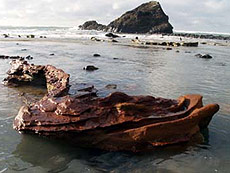 |
| The red towers look like something out of Dr. Suess, or an album cover from the band Yes |
Because of these discoveries, Chandler and Boothe headed north to Hug Point, where stumps and ghost forests also popped up.
“We discovered that the small iron formations that we saw last year were just the tip of the iceberg,” Boothe said. “These formations had been uncovered another two to three feet from last year, forming these gorgeous red structures, which my photograph do not do justice. Excited as we were, we headed up to where we had seen the stumps of the ancient forest last year expecting them to be towering above the sand. However, they were less uncovered than last year. Yep, just a couple 100 yards up the beach the sand level hadn't decreased as drastically as the beaches just south.”
Boothe said that although some of these stumps showed themselves a bit in 2007, from her talks with locals, sand levels are much lower than they have been in decades.
“I don't believe – though I could be wrong - that they have been exposed in the last 40 years,” Boothe said. “Residents of the area that I was talking with said that they had never seen the sand this low let alone seen the stumps.”
More stories on the subject:
Quick Facts About Oregon Coast Treasures, Geologic Wonders Much of the United States is focusing on the Oregon coast at this time, with various geologic developments and historic objects popping up left and right.
How To Find Oregon Coast Odd Discoveries, Artifacts If you want to play tresure hunter or geology explorer on the coast, here's a list of places to find the good stuff
The Science Behind Oregon Coast's Recent Treasures A big rush of unusual objects, some thousands to millions of years old, have been appearing on the Oregon coast. Here's why and how.
New Claims, Problems for Oregon Coast Artifacts and Oddities Artifacts recently found on the coast apparently have a new owner and some exceptionally strange tourist attractions may be in danger
Oregon Coast Relics Gone in Three Months Without Preservation Methods The now-famous cannon would fall apart in three months without current preservation methods, and restoring these could take as long as two years, officials said.
Treasures, Shipwrecks Create Huge Publicity for Oregon Coast It may be the biggest chunk of press the Oregon coast received since Keiko the Whale or the New Carissa shipwreck, and it's helping after the economic damage done by media coverage of the December storm
 |
|
Tradewinds Motel, Rockaway Beach. All rooms are immaculate and have TV’s, VCR’s and in-room phones w/ data ports. Oceanfronts have queen bed, a double hide-a-bed, kitchen, cozy firelog fireplace and private deck. Both types sleep up to four people. Others are appointed for a two-person romantic getaway, yet still perfect for those on a budget. Elaborate oceanfront Jacuzzi suite has two bedrooms, kitchen, double hide-a-bed, fireplace and private deck, sleeping as many as six. For family reunions or large gatherings such as weddings, some rooms can connect to create two-room and three-room suites. Some rooms pet friendly. 523 N. Pacific St., Rockaway Beach. (503) 355-2112 - 1-800-824-0938. www.tradewinds-motel.com |
 Inn
at Cannon Beach. Beautifully wooded natural setting at quiet south
end of Cannon Beach. Great during winter storms with a new book by
the fireplace – or when the sun is out for family fun and beach
strolling. Handsome beach cottage-style architecture. Lush flowering
gardens and naturalized courtyard pond. Warm, inviting guest rooms.
Continental buffet breakfast. Warm Cookies. Family and Pet Friendly.
Welcome gifts. Smoke-free. Complimentary Wireless Connectivity. Wine
and book signing events. 800-321-6304 or 503-436-9085. Hemlock At
Surfcrest, Cannon Beach, Oregon. www.atcannonbeach.com. Inn
at Cannon Beach. Beautifully wooded natural setting at quiet south
end of Cannon Beach. Great during winter storms with a new book by
the fireplace – or when the sun is out for family fun and beach
strolling. Handsome beach cottage-style architecture. Lush flowering
gardens and naturalized courtyard pond. Warm, inviting guest rooms.
Continental buffet breakfast. Warm Cookies. Family and Pet Friendly.
Welcome gifts. Smoke-free. Complimentary Wireless Connectivity. Wine
and book signing events. 800-321-6304 or 503-436-9085. Hemlock At
Surfcrest, Cannon Beach, Oregon. www.atcannonbeach.com. |
 |
A1 Beach Rentals, Lincoln City. Perfect for large family vacations all the way down to a getaway lodging for two - with over 25 vacation rental homes to choose from. A breathtaking collection of craftsman or traditional beachfront homes, or oceanview houses – from one to seven bedrooms. In various areas of Lincoln City and overlooking the beach, with some in Depoe Bay. All kinds of amenities are available, like hot tubs, decks, BBQ, rock fireplaces, beamed ceilings and more. Some are new, some are historic charmers. Lincoln City, Oregon. 1-(503)-232-5984. www.a1beachrentals.com. |
Weiss' Paradise Suites & Vacation Rentals - Seaside Unique Luxury Accommodations in Seaside. 1BR Suites,
1BR & 2BR Duplex Units and 3BR Houses, units for 2-8 people.
Rent entire property for 20-26. Close to beach, river and Broadway
St. |
Lincoln City Vacation Homes Something for everyone: smaller homes with a view to a large house that sleeps 15. All are either oceanfront or just a few steps away – all with a low bank access and fantastic views. Most are in the Nelscott area; one is close to the casino. You’ll find a variety of goodies: fireplaces, multiple bedrooms, dishwashers, Jacuzzis, washer/dryers, hot tubs, cable TV, VCR, barbecues; there’s a loft in one, and another sprawling home has two apartments. Pets allowed in some homes – ask first. Each comes with complete kitchens. Most have seventh night free. Prices range from winter $85 to summer $230 per night. www.getaway2thecoast.com. 541-994-8778. |
RELATED STORIES
Click here for video of Dec. storm aftermath
Oregon Coast Best of Awards for the Year And the winners are: best of Oregon coast restaurants, lodgings, science, odd events in nature and stunning moments for 2007
Oregon Coast Travel Site Goes Wireless Provides Lodging Reports - Oregon Coast Beach Connection now has mobile lodging and dining listings, along with weekly lodging availability reports
|
Oregon coast mileage chart & map Day trips, suggested itineraries Search for Oregon Coast Subjects, Articles Oregon Coast Complete Guides every beach access, attraction |
|||||||||||||
OR
TAKE THE VIRTUAL TOUR |
|||||||||||||
|











